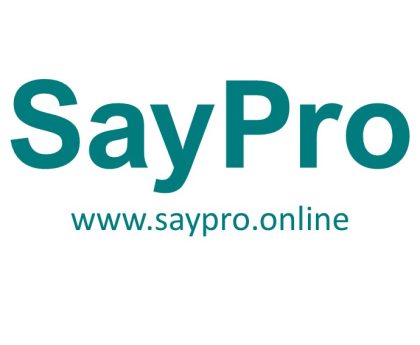SayPro Inventory Turnover Target: Achieve an inventory turnover rate of 6 times during Q2. by SayPro Online Marketplace Office under SayPro Marketing Royalty SCMR
Overview
The inventory turnover rate is a critical metric that measures how efficiently SayPro manages its stock by indicating how many times inventory is sold and replaced over a specific period. For Q2, the target is to achieve an inventory turnover rate of 6 times, reflecting a balanced approach to maintaining sufficient stock while minimizing holding costs and reducing the risk of obsolete inventory.
Achieving this turnover rate ensures optimized inventory levels, improved cash flow, and better alignment with customer demand, ultimately supporting SayPro’s strategic goals in the online marketplace.
Detailed Explanation
1. Definition of Inventory Turnover Rate
Inventory turnover rate is calculated as: Inventory Turnover=Cost of Goods Sold (COGS)Average Inventory\text{Inventory Turnover} = \frac{\text{Cost of Goods Sold (COGS)}}{\text{Average Inventory}}Inventory Turnover=Average InventoryCost of Goods Sold (COGS)
- Cost of Goods Sold (COGS): The direct costs attributable to goods sold during the period.
- Average Inventory: The average value of inventory held during the same period (typically calculated by averaging opening and closing inventory balances).
A turnover rate of 6 times means SayPro aims to sell and restock its entire inventory six times during Q2.
2. Importance of the Target
- Optimizing Stock Levels: A turnover of 6 ensures SayPro keeps stock fresh and aligned with customer demand, avoiding overstocking or stockouts.
- Reducing Holding Costs: Faster turnover reduces storage and insurance costs, freeing capital for other business needs.
- Improving Cash Flow: Frequent turnover accelerates cash recovery from sales, supporting reinvestment.
- Minimizing Obsolescence: High turnover reduces the risk of inventory becoming outdated or unsellable.
- Enhancing Customer Satisfaction: Well-managed inventory means better product availability and timely order fulfillment.
3. Strategies to Achieve the Target
a. Demand Forecasting and Planning
- Use real-time sales data and market trends to forecast demand accurately.
- Adjust stock levels proactively based on seasonal fluctuations or promotional activities.
b. Inventory Optimization
- Implement just-in-time (JIT) inventory practices to reduce excess stock.
- Regularly review slow-moving items and develop plans to clear or discontinue them.
c. Supplier Collaboration
- Work closely with suppliers to ensure timely deliveries and flexible order quantities.
- Negotiate shorter lead times to allow more responsive restocking.
d. Enhanced Stock Tracking
- Utilize SayPro’s internal tracking tools for real-time visibility of stock movements.
- Quickly identify discrepancies and take corrective actions to prevent stock imbalances.
e. Sales and Marketing Alignment
- Coordinate promotions and campaigns to stimulate demand on inventory that requires faster turnover.
- Analyze customer buying patterns to support targeted marketing efforts.
4. Monitoring and Reporting
- Weekly and Monthly Reports: Generate detailed inventory turnover reports, highlighting progress towards the Q2 target.
- Dashboard Metrics: Use visual dashboards to track turnover rates by product category and overall.
- Exception Alerts: Set up automated alerts for unusually low or high turnover rates to prompt immediate review.
5. Roles and Responsibilities
- Inventory Management Team: Monitor stock levels, perform turnover calculations, and report findings.
- Procurement Team: Coordinate with suppliers for timely deliveries and order adjustments.
- Sales and Marketing: Drive demand generation aligned with inventory optimization goals.
- IT Team: Maintain and enhance inventory tracking systems for accurate data.
6. Expected Outcomes
- Achievement of an inventory turnover rate of 6 times by the end of Q2.
- Improved stock availability aligned with customer demand.
- Reduced storage costs and better working capital management.
- Enhanced overall operational efficiency in inventory handling.
Conclusion
Setting a clear and ambitious inventory turnover target of 6 times during Q2 empowers SayPro Online Marketplace Office to focus on effective inventory management practices. Through coordinated efforts across teams, continuous monitoring, and data-driven strategies, SayPro aims to optimize stock levels, reduce costs, and improve customer satisfaction in the competitive online marketplace environment.

